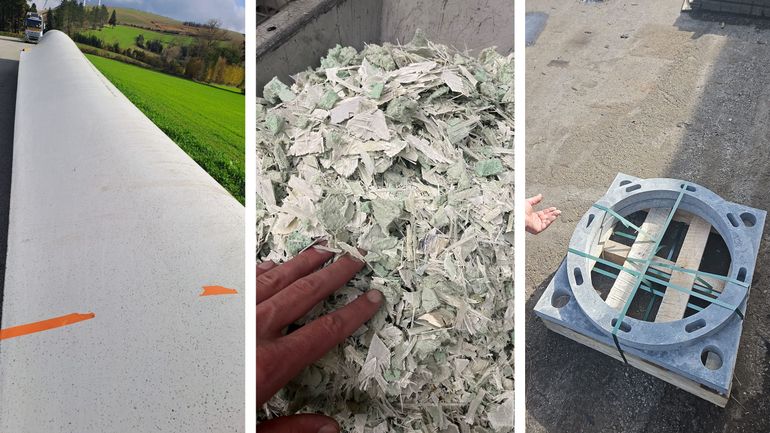
Eolienne
Recyclage : Reprocover à Petit Rechain broie les pales d’éoliennes – RTBF Actus
Why Reprocover tackles wind blade recycling
At Reprocover, we’re proud to highlight our innovative techniques for recycling composites, with a special focus on wind turbine blades. While wind blades are not our preferred composite material, we’ve developed processes to recycle parts of them effectively.
Why are wind blades challenging to recycle?
- Limited transparency
wind blade manufacturers are often secretive about the exact composition of their materials, creating significant challenges for traceability and raw material specifications. If manufacturers provided detailed material specifications for each blade, the recycling process would become much more economically viable. - A call for collaboration
despite these challenges, other industries have shown more openness in sharing such data, making their materials easier to recycle. If wind blade manufacturers are willing to work with us transparently and confidentially, we would be pleased to deepen our focus on wind blade recycling.
How does Reprocover recycle wind blades?
Reprocover has developed a unique process to handle this complex material. Here’s how it works:
- Breaking it down
old wind turbine blades consist of various materials—fiberglass, resins, and adhesives—assembled in layers to give them strength. These mixed materials are difficult to recycle, but Reprocover breaks them into very small pieces to recover the valuable fibers. - Creating reusable materials
after shredding, the resulting material resembles a plastic composite. As charles göbbels, managing director and shareholder of Reprocover, explains:
“it’s like a conglomerate of plastic—fiberglass held together by resin. The stratifications within the material provide the blade’s strength, and we focus on preserving this rigidity in the recycling process.” - Customized fiber preparation
in Reprocover’s facility, specialized shredders and separators process the material into a range of fiber sizes:- Long fibers (up to 25mm) for maintaining mechanical properties
- Short fibers (down to 10mm) for use as a replacement for virgin fibers
- Powdered fibers (under 100 microns) to substitute fillers or additives in other industries
- Reintegrating fibers into new products
the recovered fibers are mixed with a resin to form new composite materials, maintaining their mechanical properties. These composites are then used to produce cable gutter / cable through channels, utility chambers, and other infrastructure components for water, gas, telecom, and railway sectors.
Economic and environmental perspectives
Recycling wind blades follows a “polluter pays” model. Owners of old wind turbines pay for the recycling service, ensuring that the process remains financially viable. Although we are still in the prototyping phase for wind blades due to traceability issues, Reprocover has already recycled 60 tons of old turbine blades and more than 2 000 tons of composites.
Looking ahead
Reprocover is committed to expanding its capabilities in wind blade recycling, but greater collaboration and transparency from manufacturers would unlock even greater potential.
If you’re a wind blade manufacturer open to working on transparent and sustainable recycling solutions, or if you’re seeking innovative ways to manage composite waste, we’d love to explore possibilities with you.
Together, we can push the boundaries of recycling and circularity, one wind blade at a time.
#recyclage, #éolien, #bladerecycling, #recyclingvanwindturbines, #WindkraftRecycling, #sustainability, #Reprocover, #CircularEconomy
